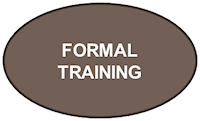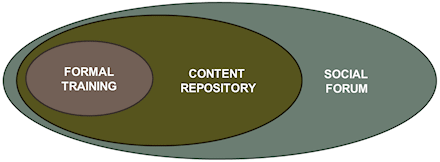User-generated content (UGC) is not a novel concept, but most of us in the corporate sector have barely scratched its surface.
Beyond enterprise social networks – which are hardly universal and face substantial challenges of their own – UGC in the broader sense is beset by concerns about content quality, accountability, organisational culture, job security and power dynamics.
And yet… the world is changing.
Notwithstanding either the validity or the importance of our concerns with UGC, the traditional training model is becoming increasingly unsustainable in the modern workplace. And besides, I think most of our concerns can be addressed by a change in mindset, a little imagination, a dash of trust, and a collective commitment to make it work.
To explore the practicalities of user-generated content, the Learning Cafe sponsored a webinar entitled Learner Generated Learning Content – Possibilities, mechanics and chaos? The event was hosted by Jeevan Joshi and presented by myself, Andrew Mazurkiewicz and Cheryle Walker.
My part comprised a proposed solution to a fictional case. Both the case and the transcript of my proposal are outlined below…

The case
Ron is the manager for a 250 seat contact centre at an insurance company in 3 locations. Ron has made sure that there is a comprehensive training program to cover all aspects of the job. However in the past 6 months improvements have plateaued despite improving the content and structure of the training workshops. Ron did an analysis of contact centre data and concluded that further improvements were only possible if practical knowledge and better practices known to the team were shared in the team.
Denise, a team leader suggested that operators would be keen to share how they dealt with difficult or complex calls using the web cam on the PC and post it on the intranet. Ron was concerned that recording may be a distraction and may be perceived by some as monitoring performance. Kit, the Learning Consultant insisted the videos should be loaded on the LMS so that the time spent and results could be tracked. There were also concerns that inappropriate videos may be posted. Denise was however convinced that it was a good idea and the only way to improve further performance. What should Ron do?
My proposal

Well firstly I think Ron should retain his formal training program. It’s important for the organisation to cover off its “must know” knowledge and skills, and formal training can be a quick and efficient way of doing that. Besides, moving away too radically from formal training would probably be a culture shock for the company, and thus counter-productive. So in this case I suggest it would be best to build on the foundation of the training program.
Training is the front end of an employee’s learning & development. I know from first-hand experience that there is a lot for contact centre staff to take in, and they can’t possibly be expected to remember it all. So the formal training needs to be sustained, and a powerful way of doing that is with an informal learning environment.

A key component of the informal learning environment is the content repository – such as an intranet or a wiki – that contains content that the employee can search or explore at their discretion. The logical place to start with this content is with the existing training collateral. Now, I don’t mean simply uploading the user guides, but extracting the information and re-purposing it in a structured and meaningful way on-screen.
If Denise knows operators who are keen to generate content, then I would certainly welcome that. These people are the SMEs – they live and breathe the subject matter every day – so they are the obvious choice to add value.
However, I’m not sure if web cams are necessarily the way to go. In the case of dealing with difficult calls, audio would be a more authentic choice; visuals wouldn’t add anything to the learning experience – in fact, they’d probably be distracting. The operator could request a particular recording from the quality system and write up in text how they handled the call. And if they used a tool like Audacity, they could easily cut and edit the audio file as they see fit.
Another way of generating content – especially for process and system training – might include Captivate or Camtasia, which are really easy to use to produce handy tutorials.
An important point to remember is that the operator on the phone might need to look up something quickly. For example, if they have an angry or abusive caller on the other end of the line, they won’t have the luxury of wading through reams of text or listening to a 7-minute model call. So it’s important that the practical knowledge be provided in the form of job aids – such as a template or a checklist – that the operator can use on-the-job, just-in-time.
I don’t agree with Kit that this content should be put on the LMS. Frankly, no one will go in there – and in my opinion, that’s not what an LMS is for. By definition, an LMS is a Learning Management System – so use it to manage learning. It makes sense to use the LMS for the formal training program – for things like registrations, grading, transcripts, reporting etc. In contrast, what we’re talking about here is the act of learning – not its management. The operator needs a resource that is easy to access, easy to navigate, to learn what they need to do their job in the moment.
We must remember that the point of learning is performance – so the focus of our measurement and evaluation energies should be on the performance stats. The employees would have been thoroughly assessed during the formal training program, so now is not the time to go loading the LMS with more stuff just for the sake of tracking it. The real tracking now should be done with the business scorecard.

OK, a missing link in this solution is a social forum.
If an operator can’t find what they need, a social forum enables them to ask their crowd of peers. And again, because these peers are themselves SMEs, someone is likely to have the answer. Not only does this approach service the operator with the information they need, but other operators can see the interaction and learn from it as well.
Also, by keeping tabs on the discussions in the forum, the L&D professional can identify gaps in the solution, and review the content that is evidently unclear or difficult to find.
So in summary, my solution for Ron is an integrated solution comprising his formal training program, complemented by an informal learning environment including a structured content repository, which in turn is complemented by a social forum.
Those among us who like the 70:20:10 model will see each component represented in this solution.

Do you agree with my integrated solution? What else would you recommend, or what would you propose instead?
Are we witnessing the dawn of a new generation? Can user-generated content be a core component of the corporate L&D strategy? Or is it just a pipe dream?